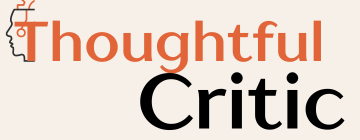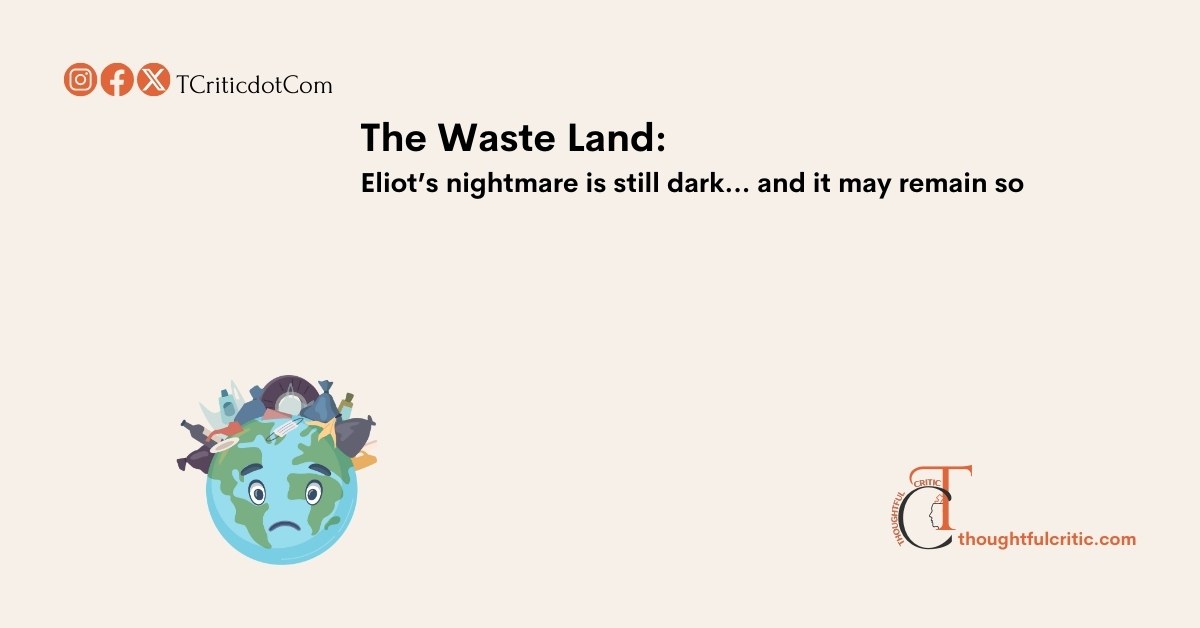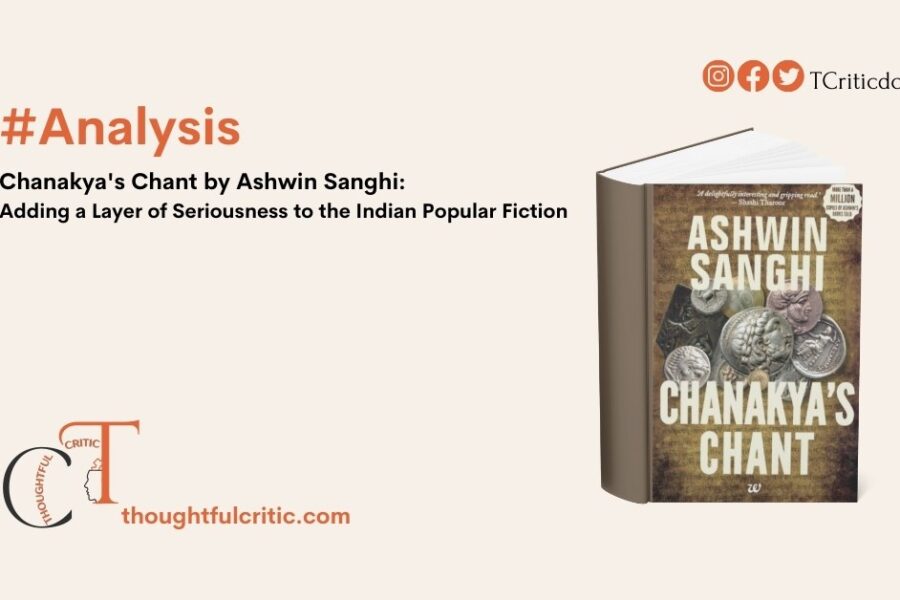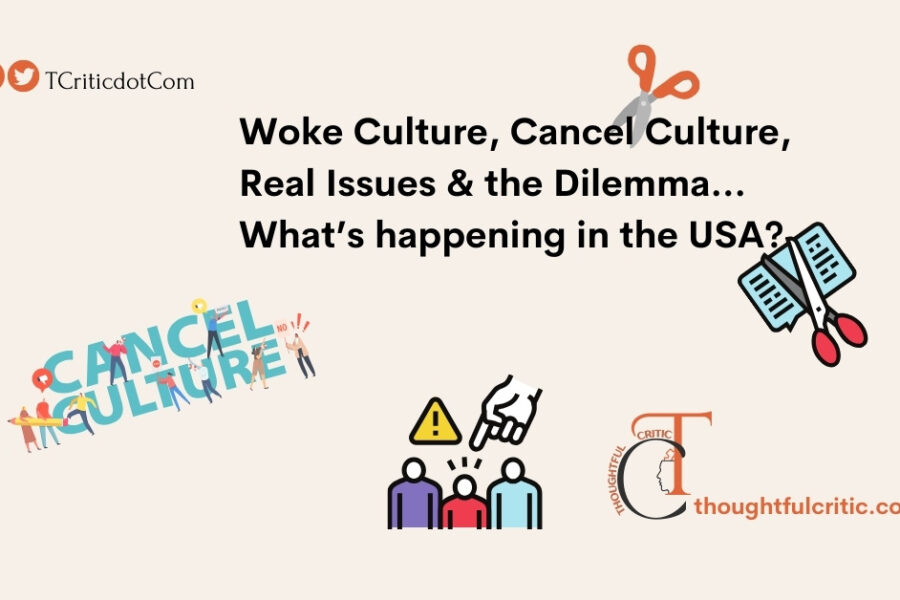T.S. Eliot’s The Waste Land (1922) remains one of the most haunting and prophetic poems of the 20th century—a fragmented, disillusioned vision of a civilisation in decay. Written in the aftermath of World War I, the poem depicts a world stripped of meaning, where spiritual desolation, mechanical repetition, and cultural amnesia dominate. A century later, as we navigate global crises—climate collapse, political extremism, algorithmic alienation—Eliot’s wasteland feels unnervingly familiar. But has humanity learned from its mistakes, or are we merely repeating them in digital form? This essay revisits The Waste Land through a contemporary lens, examining whether Eliot’s diagnosis still holds and what, if anything, we’ve done to replant the ruins.
The Barren Landscape Then and Now
Eliot’s wasteland is a place of drought and sterility, where “the dead tree gives no shelter, the cricket no relief” (The Burial of the Dead). This imagery mirrors the existential exhaustion of post-war Europe, where faith in progress had collapsed alongside empires. Today, our droughts are literal and metaphorical: wildfires ravage continents, while social media feeds—overflowing with content yet devoid of connection—mirror Eliot’s “heap of broken images.” The poem’s famous refrain—“Hurry up please, it’s time”—echoes in our frenetic, doomscrolling culture, where attention spans wither and discourse is reduced to slogans. Even Eliot’s portrayal of sex as mechanical and joyless (“The typist home at teatime […] prepares for seduction”) finds its counterpart in the commodification of intimacy through dating apps and pornography. The wasteland, it seems, has simply upgraded its infrastructure.
Myth, Memory, and Cultural Amnesia
Eliot’s The Waste Land is a tapestry of mythic fragments—from the wounded Fisher King whose impotence mirrors the sterility of his kingdom, to the Sanskrit invocation of “Datta, Dayadhvam, Damyata” (Give, Sympathise, Control) from the Brihadaranyaka Upanishad. These references are not mere allusions but desperate attempts to “shore up” civilisation’s ruins with the wisdom of the past. Eliot’s modernist collage technique—juxtaposing Dante with pub conversations, Wagner with ragtime—reflects a world where cultural memory has shattered, leaving only disjointed remnants. The poem’s famous declaration, “These fragments I have shored against my ruins,” is both a lament and a survival strategy: without coherent traditions, art becomes an archaeological dig through the layers of human consciousness.
A century later, our relationship with history has not healed but metastasised. Where Eliot’s era grappled with the aftermath of mechanised warfare and the collapse of Victorian certainty, ours faces a paradox: never before has so much information been so accessible, yet never has collective memory been so shallow. Algorithms—the unseen priests of the digital age—curate our engagement with the past, privileging novelty over depth, reducing history to viral snippets and trending hashtags. Today’s average person encounters historical references not through Homer or Shakespeare but through memes, where complex legacies are flattened into punchlines or propaganda. Consider how political movements weaponise nostalgia: slogans like “Make America Great Again” or “Take Back Control” invoke a mythic past while willfully ignoring its contradictions—slavery, colonialism, or systemic inequality. This is not accurate remembrance but a kind of historical taxidermy, stuffing the past with simplistic narratives to serve present agendas.
Eliot’s Sibyl, the prophetic figure from Greek myth who is granted eternal life but not eternal youth, becomes a chilling metaphor for our predicament. Trapped in her jar, she withers into a voice without a body, whispering “I want to die”—a premonition of our own era’s information overload. With its infinite scroll and endless archives, the internet offers a similar curse: a deluge of data that drowns meaning. We know more facts than ever, but understand less; we have more platforms for expression but fewer shared truths. The Sibyl’s fate mirrors the modern psyche, glutted on content yet starved of wisdom, longing for an end to the noise.
Yet amid this desolation, there are flickers of resistance—attempts to reassemble the fragments Eliot mourned. Grassroots movements are reviving indigenous practices, from seed-saving rituals to oral storytelling, recognising that ecological and cultural survival are intertwined. In Chile, the Mapuche people’s struggle for land rights echoes the Fisher King myth, linking territorial sovereignty to spiritual renewal. Meanwhile, Gen Z’s ironic embrace of The Waste Land on TikTok—where lines like “I will show you fear in a handful of dust” soundtrack videos about climate anxiety or mental health—suggests that Eliot’s vision still resonates. The poem’s fragmentation, once a symptom of collapse, now feels eerily suited to a generation raised on jump cuts and hyperlinks. Even the meme-ification of classic literature, though often reductivist, can serve as a gateway: a teenager might encounter the “Unreal City” of London Bridge through a viral edit before diving into the full text.
The question is whether these fragments can cohere into something living. Eliot’s poem ends not with resolution but with a fractured incantation: “Shantih shantih shantih”—a borrowed peace that feels more like exhaustion than transcendence. Today, our tools for reassembling the past are both powerful and perilous. Digital archives preserve vanishing languages; crowdsourced projects transcribe slave narratives or Holocaust testimonies. Yet these efforts compete with the forces of erasure: censorship, algorithmic bias, the deliberate burning of libraries (literal and digital) in wars from Syria to Ukraine. The wasteland, it seems, is not a fixed condition but a cycle—one we are both perpetuating and, haltingly, trying to break.
In this light, The Waste Land is less a diagnosis than a mirror. Eliot showed us a civilisation cannibalising its heritage; today, we must ask whether we’re doing the same with sharper tools. The poem’s brilliance lies in its refusal to offer easy redemption. Like the Sibyl, we are suspended between death and rebirth, fragments and wholeness, knowing the problem yet struggling to solve it. The thunder still speaks, if we can learn to listen.
Spiritual Desolation and the Search for Meaning
Religion in The Waste Land is a hollow ritual: the crowd walking in circles over London Bridge echoes Dante’s damned, and the sermon in The Fire Sermon preaches detachment without transcendence. Today, institutional religion wanes, but spiritual hunger persists—manifested in wellness cults, psychedelic revivalism, and conspiratorial QAnon theology. Eliot’s “Unreal City” parallels the metaverse and influencer culture, where identity is performative and commodified. Yet the poem’s closing mantra—“Shantih shantih shantih” (the peace that surpasses understanding)—hints at a yearning for reconciliation. Modern parallels might include mindfulness movements or ecological activism, which seek to restore balance in a fractured world.
Have We Learned Anything?
Eliot’s wasteland is cyclical: its inhabitants repeat mistakes, trapped in “a pattern of timeless moments.” The 21st century suggests we’re no different. Climate denial repeats the hubris of industrialism; nationalism revives the ghosts of 1914; and digital alienation perpetuates Eliot’s fear that “we think of the key, each in his prison.” Yet there are signs of awakening. The poem’s call to “give, sympathise, control” aligns with today’s mutual aid networks and climate justice efforts. The difference is that Eliot saw redemption as individual and mystical (“the awful daring of a moment’s surrender”), while modern activism demands collective action.
Conclusion: Replanting the Wasteland
The Waste Land endures because it captures a universal tension between decay and renewal. Eliot’s world, like ours, was trapped between catastrophe and hope. The question isn’t whether we’ve learned—it’s whether we’re learning. The poem’s final image of thunder promising rain suggests that sterility isn’t permanent. Today, that rain might be the rise of degrowth economics, indigenous land stewardship, or even the quiet act of reading a poem deeply, resisting the fragmentation Eliot feared. The wasteland is still here, but so are the seeds.
Priya for Thoughtful Critic




